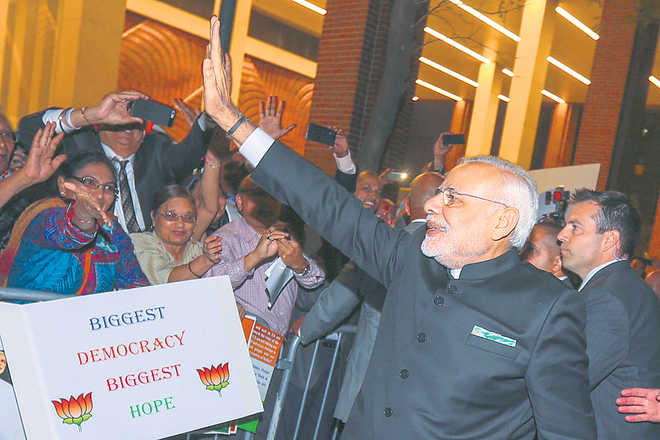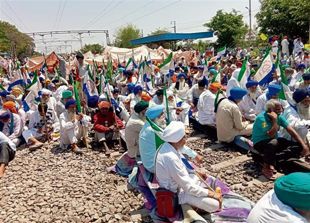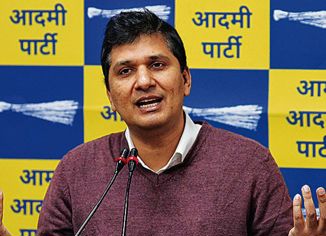
Growth path: Mere talks and waving national flags won’t take India forward.
KC Singh
THIS column is a letter from Silicon Valley, California. The fabled vale stretches from the southern periphery of San Francisco, past the airport to San Jose. The heart of the technology innovation revolution lies at Palo Alto and the campus of Stanford University. In fact, the world famous technology names on buildings can be seen all around the over 8,000 acre campus established by Californian politician and railway tycoon, Leland Stanford, in 1885. The fable is that the president of Harvard rebuffed his offer of a huge grant in the name of son Leland Jr, who died of typhoid at 15, leading to Stanford being born.
My host and guide is former Sanawarian Satjiv S Chahil, whose parents once lived in Chandigarh. He began with Xerox in the 1980s on the business development side at the Palo Alto Research Centre. It was this lab that spawned elements of personal computing like desktop Graphical Use Interface and the mouse, etc. Thus while the Palo Alto lab pioneered most of the technologies that are today basic to a paperless world, the Xerox corporate headquarters on the east coast saw little commercial use for them. Their loss was the gain of Apple and Microsoft who weaned away frustrated Xerox employees looking to chase dreams. The rest, as they say, is history.
Silicon Valley today is teaming with startups, conventions at which innovators and venture capital hawkers can interact, and constant churning to look into the future. Satjiv himself moved to Apple in 1988, following many others seeking a more innovative environment. One middle-level entrepreneur summed it up, saying that after the last burst of innovation that gave Über, etc. everyone is waiting for the next disruptive innovation, as in the past couple of years nothing new has emerged.
Silicon Valley’s placid environs, amidst rolling hills and salubrious weather, appear detached from the anxieties of global geopolitics today. In a fortnight, while on golfing vacation, President Donald Trump has issued a nuclear threat to Democratic People’s Republic of North Korea (DPRK) through a colourful phrase “fire and fury”; threatened Venezuela with military intervention; and flirted with white supremacists and neo-Nazis.
The problems of India appear so distant from here on the other side of the globe. The Doklam standoff persists with occasional growls from China hinting at military retaliation. The ghastly death toll of children in a Gorakhpur hospital climbed over 60 as the union government remains mum and the state government in Lucknow keeps shifting the blame to lower-level functionaries, despite the hospital being in the city Chief Minister Yogi Adityanath has represented for decades in the Lok Sabha. The difference between India and the US is that the lambasting of Donald Trump over his vague condemnation of the white supremacists in Charlottesville violence, which made him do a reluctant about turn, is in complete contrast to Narendra Modi getting away with similar dissimulation or silence over gau rakshaks or lynchings in broad daylight of minority or Scheduled Caste persons, or now the children’s death.
In the US, more and more analysts are beginning to wonder whether their President lacks stability which the leader of the “free world”, possessing a deadly nuclear arsenal, by definition must have. Trump’s DPRK bashing is however helpful to India as it is keeping China massively distracted due to two factors. One, China would like DPRK to be a pliable and not reckless buffer with the Republic of Korea, as indeed a useful foil to Japan. Two, it does not want a war, with the possibility of use of nuclear devices by either or both sides, particularly when it is heading into its crucial 19th party congress later this year. Logically, China would not want to exacerbate relations with India at this point, having its hands full on its eastern frontier.
It is possible even the new UN sanctions against DPRK, which are likely to further squeeze its $3 billion worth of exports, may only condition good behaviour temporarily, if at all. On the other hand, if China is able to extricate Trump honourably from this mess, he is unlikely to press China on trade and geopolitical issues that do not directly impinge on US interests. The Doklam standoff outcome would depend thus on how the US-DPRK issue pans out.
This year is the centennial of the Russian Revolution which by its ideology and Soviet military rise dominated the 20th century geopolitics. It is also a decade since the financial crisis which compelled questions to be asked about the viability of the Western liberal economic order. The second event also emboldened China to assertively reclaim its imagined position as a global power, equal or even superior in future to the US. Trump, by his unwise clamping down on movement of human resources to the US on populist and fallacious ground of protecting US jobs, is actually crippling US innovation resting on attracting talent from across the globe.
Silicon Valley’s success and the rise of innovative new companies as the Xeroxes of the US floundered due to static visions is a lesson that the US strengthens from open doors and welcome mats. Charlottesville symbolises the fight-back by regressive forces seeking to march to the past. While the US is thus preoccupied, the world is not waiting. A Chinese billionaire is weaning away talent from German car-makers and Silicon Valley electric car researchers to create in Los Angeles a rival to Tesla — the pioneer in the field. This is the Chinese way of capturing technology.
India too needs to become proactive and establish a free zone, ideally on an island chain, with minimum regulatory control and lax taxation, to wean away talent from Silicon Valley worried about the narrowing US vision. A condition precedent would have to be PM Modi showing he can carry the whole nation with him. Waving national flags and singing anthems reduces nationalism to symbolic gestures. To achieve national prosperity and global power, India needs a nurturing, non-intrusive state and centres of innovation built around citadels of learning. India needs many Leland Stanfords and Steve Jobs.
The writer is a former Secretary, Ministry of External Affairs



























